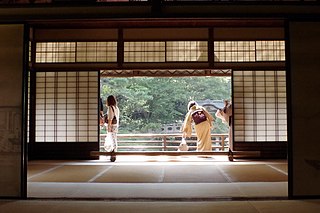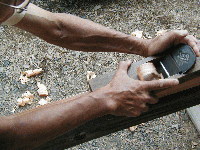
Carpentry is a skilled trade and a craft in which the primary work performed is the cutting, shaping and installation of building materials during the construction of buildings, ships, timber bridges, concrete formwork, etc. Carpenters traditionally worked with natural wood and did rougher work such as framing, but today many other materials are also used and sometimes the finer trades of cabinetmaking and furniture building are considered carpentry. In the United States, 98.5% of carpenters are male, and it was the fourth most male-dominated occupation in the country in 1999. In 2006 in the United States, there were about 1.5 million carpentry positions. Carpenters are usually the first tradesmen on a job and the last to leave. Carpenters normally framed post-and-beam buildings until the end of the 19th century; now this old-fashioned carpentry is called timber framing. Carpenters learn this trade by being employed through an apprenticeship training—normally 4 years—and qualify by successfully completing that country's competence test in places such as the United Kingdom, the United States, Canada, Switzerland, Australia and South Africa. It is also common that the skill can be learned by gaining work experience other than a formal training program, which may be the case in many places.

A hand tool is any tool that is powered by hand rather than a motor. Categories of hand tools include wrenches, pliers, cutters, files, striking tools, struck or hammered tools, screwdrivers, vises, clamps, snips, hacksaws, drills, and knives.
Takenaka Corporation is one of five major general contractors in Japan. Takenaka provides architectural, engineering, and construction services and has its headquarters located in Chūō-ku, Osaka, Osaka Prefecture. Takenaka has eight domestic offices in Japan with overseas offices in Asia, Europe, and the United States. It has remained under family control since the founding of Takenaka Corporation in 1609, and is currently led by the 17th generation of the family.

A smoothing plane or smooth plane is a type of bench plane used in woodworking. The smoothing plane is typically the last plane used on a wood surface, removing very fine shavings to leave a smooth finish. When used effectively it quickly produces a finish that equals or surpasses that made by sandpaper.

The Japanese saw or nokogiri (鋸) is a type of saw used in woodworking and Japanese carpentry that cuts on the pull stroke, unlike most European saws that cut on the push stroke. Japanese saws are the best known pull saws, but they are also used in China, Iran, Iraq, Korea, Nepal and Turkey. Among European saws, both coping saws for woodworking and jeweler's saws for metal working also cut on the pull stroke like Japanese saws. Cutting on the pull stroke is claimed to cut more efficiently and leave a narrower cut width. On the other hand, a pull stroke does not easily permit putting one's body weight behind a stroke. This can be readily solved by using a vice or clamping. Another disadvantage, due to the arrangement and form of the teeth, is that Japanese saws do not work as well on hardwoods as European saws do. Japanese saws were originally intended for comparatively soft woods like cypress and pine whereas European saws were intended for hard woods like oak and maple.

A shoji is a door, window or room divider used in traditional Japanese architecture, consisting of translucent sheets on a lattice frame. Where light transmission is not needed, the similar but opaque fusuma is used. Shoji usually slide, but may occasionally be hung or hinged, especially in more rustic styles.

A jack plane is a general-purpose woodworking bench plane, used for dressing timber down to size in preparation for truing and/or edge jointing. It is usually the first plane used on rough stock, but for rougher work it can be preceded by the scrub plane. The versality of the jack plane has led to it being the most common bench plane in use. The name jack plane is sometimes used interchangeably with the longer fore plane.

Japanese carpentry was developed more than a millennium ago through Chinese architectural influences such as Ancient Chinese wooden architecture and uses woodworking joints. It involves building wooden furniture without the use of nails, screws, glue or electric tools.

The Japanese plane or kanna (鉋) is a plane pulled towards the user rather than pushed in the manner of western style planes. They are made of hardwood, usually Japanese white or red oak. The laminated steel and iron blade is stout compared to western planes. Tapered in length and thickness, the plane blade is its own wedge, as it fits into a correspondingly-shaped mortice in the body of the plane, thus dispensing the need for a separate wedge to hold the blade in place, as is the case in most other traditional wooden planes. The chip breaker is held in place with a simple nail inserted some distance away from and perpendicular to the axis of the main blade. The chip breaker is not tapered like the main blade; instead, it has bent "ears" that bear down on the plane blade. Chip breakers in Japan were introduced relatively recently, during the Meiji period. The soles of Japanese planes also have different configurations for varying applications. The apparently simple design disguises a great deal of complexity.

A bench hook is a workbench appliance used in woodworking to hold a workpiece in place while crosscutting with a hand saw. A bench hook is a simple method used to improve accuracy and safety.

A marking knife or striking knife is a woodworking layout tool used for accurately marking workpieces. It is used to cut a visible line, which can then be used to guide a hand saw, chisel or plane when making woodworking joints and other operations. They are generally used when marking across the grain of the wood, with scratch awls better suited for marking with the grain.
Although an antique tool might be said to be one that is more than a hundred years old, the term is often used to describe any old tool of quality that might be deemed collectable.
Mieko Shiomi is a Japanese artist, composer, and performer who played a key role in the development of Fluxus. A co-founder of the seminal postwar Japanese experimental music collective Group Ongaku, she is known for her investigations of the nature and limits of sound, music, and auditory experiences. Her work has been widely circulated as Fluxus editions, featured in concert halls, museums, galleries, and non-traditional spaces, and re-performed by other musicians and artists numerous times. She is best known for her work of the 1960s and early 1970s, especially Spatial Poem, Water Music, Endless Box, and the various instructions in Events & Games, all of which were produced as Fluxus editions. Now in her eighties, she continues to produce new work.

Since their invention and subsequent proliferation in the mid-20th century, ballpoint pens have proven to be a versatile art medium for professional artists as well as amateur doodlers. Ballpoint pen artwork created over the years have been favourably compared to art created using traditional art mediums. Low cost, availability, and portability are cited by practitioners as qualities which make this common writing tool a convenient, alternative art supply.

A mortise gauge or mortice gauge is a woodworking tool used by a carpenter or joiner to scribe mortise and tenon joints on wood prior to cutting. Mortise gauges are commonly made of hardwood with brass fittings.
George Joseph Ranalli is an American modernist architect, scholar, curator, and fellow of the American Institute of Architects. He is based in New York City.
John Adamson is a British publisher, translator and writer. He specialises in illustrated books in the fine and decorative arts.
Mira Nakashima-Yarnell is an architect and furniture maker. She is the daughter of George Nakashima and is now the President and Creative Director for George Nakashima, Woodworker.

A burnisher is a hand tool used in woodworking for creating a burr on a card scraper.














